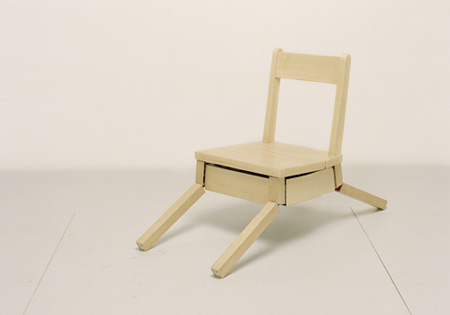This evening I saw the pieces of a wooden chair crawl along a floor, gradually assemble themselves together, and then stand up.
It was an art piece called Robotic Chair by Max Dean, Raffaello D’Andrea and Matt Donovan. The sight of this “inanimate” object slowly and patiently pulling itself together was utterly compelling. The actual mechanism was mainly built into the seat of the chair, which crawled around on the floor and, in turn, carefully docked with each of the four legs and the chair back. Once all the pieces were connected, the chair would gradually pull in its four splayed-out legs until they were vertical. And then suddenly, in one moment, it was done, and the chair simply stood there, looking for all the world like an ordinary wooden chair.
Eventually it would again collapse, and its parts would go flying. At which point the chair would set about slowly, methodically putting itself back together again from the scattered pieces.

I can’t say I’ve ever seen anything else like it. People attending the gallery opening (at the wonderful Ronald Feldman gallery) were utterly transfixed by the sight of this sisyphian chair, which would go to such great lengths to pull itself together, only to suddenly collapse again a few minutes later.
Knowing that the chair was merely executing a computer controlled algorithm did not make the experience less compelling. The piece works because it functions as art on a number of levels. Knowing that the chair is merely a robot executing a computer program takes away none of the magic, so compelling is the resulting apparition, the visceral enactment of eternal struggle, of hard won success followed by sudden collapse.
I suspect that a large part of the power of this piece comes from something very primitive within us. Human society has changed in many ways since the Cro Magnon days. We’ve developed innumerable technologies, from agriculture to the printing press, the airplane to the iPhone. But we ourselves have not changed — we are each essentially the same beings our forebears were twenty to fifty thousand years ago, before societies evolved from small hunter-gatherer tribes to large hierarchical land-based fiefdoms, presided over by presidents and popes. Long before we had our modern religions, we each had an innate sense of childlike wonder, as fundamental to our nature as walking upright and a propensity to create language.
The Robotic Chair speaks to us because, deep down, we are all animists.